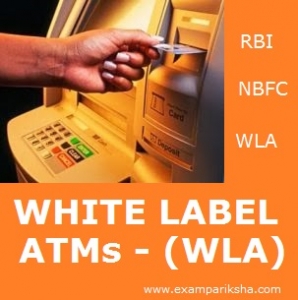In this article we are providing detailed information regarding White Label ATMs.
The ATMs or Cash dispensing machines, that are owned and operated by Non Banking Financial Corporations (NBFC) are known as White Label ATMs. These WLAs provide the banking services to the customers and clients of banks in India. In order to begin operations of White Label ATMs, the non-bank corporations must have the net worth of at least Rs 100 crore.
The Background of White Label ATM (WLAs):
Prior to setting up of WLAs, only banks were allowed to set up ATMs in India. And majority of these ATMs were covered up in urban areas. Between the years 2008 – 2011 although, nearly 23-25 % growth in the number of ATMs was seen in Tier I and Tier II cities. However, in Tier III & IV cities, the network of ATMs has remained sparse. Thus, RBI decided to rope in private operators to expand the ATM network across a broader customer base. To achieve this, the RBI reviewed the extant policy on ATMs and permitted non-bank entities that are incorporated in India under the Companies Act 1956, to set up and operate ATMs in India. The Reserve Bank of India released the guidelines on “White Label Automated Teller Machines(WLAs) in India” on 20 June 2012.

Before moving further on White Label ATMs, it is important to under the concept of Brown Label ATMs. What is Brown Label ATM meaning, how Brown label ATM is different from White Label ATM, etc. questions will be answered in the following part of the article.
What are Brown label ATM?
‘Brown label ATMs’ are those ATMs (Automated Teller Machines) which have their hardware and the ATM machine lease is owned by a service provider, while the cash management and connectivity to the banking networks is provided by a sponsor bank. The brand name of the sponsor bank is used on the Brown label ATM. The Brown label ATMs in India have began to come up as an alternative between the bank-owned ATMs and the ‘white label’ ATMs (which have just begun after approvals were granted in 2012 by RBI).
The Status of Brown label ATMs in India :
Influenced by high cost of ATM machines and also RBI’s guidelines for expansion of ATMs, banks are increasingly expanding their ATM network by means of Brown Label ATMs. There are indications that as many as 50% ATMs by banks may soon be under this category. However, with coming of white label ATMs, the scenario for expansion of ATMs will change over time.
Need for introduction of White Label ATMs
So far, the banks have played major role in setting up and encouraging usage of Automated Teller Machines (ATMs) in India. The total number of ATMs set up in India by public, private and foreign banks is around 90,000 ATMs across India, but they are mostly concentrated in the urban areas and cities. While, the other parts of country especially, the tier III to tier VI cities have not seen any substantial growth in number of ATMs, which could have popularised the personal banking in rural areas and could have played an important part in financial inclusion.
Therefore, RBI has relaxed its policy about setting up of ATMs and has allowed the participation of non-banking financial institutions to set up the White Label ATMs. These White Label ATMs are owned and operated by the NBFCs while functioning just in the same way as any other bank-run ATM does.
- The RBI aims at expanding the reach of banking services in rural areas since the non-banking financial companies have to maintain a certain ratio of their ATMs between the rural and urban India.
- RBI wants to expand the ATM network to ensure financial inclusion. With more and more people indulging in personal banking and having easy access to cash, white label ATMs will deepen the reach of banking services.
What is a White Label ATM (WLA)
White Label ATMs are operated by a non-bank entity where customers from any bank may withdraw money. WLAs are ATMs that are deployed by the non-banking financial companies which charge banks a fee whenever the account holders transact. A white-label ATM (WLA) is not owned by a bank but by a private service provider and established under Payments & Settlements Act of 2007.
White Label ATMs are mainly aimed at achieving financial penetration across Tier-I to Tier-VI regions of the country particularly in semi-urban and rural areas. Customers of any bank in India can access these White Label ATMs.
The RBI has licensed seven NBFCs to setup White Label ATMs, these are — Tata Communications Payment Solutions (TCPS), BTI Payments, Prizm Payment, Srei Infrastructure, Muthoot Finance, RiddiSiddhi Bullions and Vakrangee Limited.
First White Label ATM was set up by Tata Communications Payment Solutions, by the brand name of ‘Indicash‘.
Guidelines for White Label ATMs (WLAs)
Since White-label ATMs were introduced to increase the ATM network in semi-urban and rural areas, the RBI has taken measures to ensure this reach. The companies in the WLA segment are mandated to operate 67 % of their ATMs in rural locations (which are tier III to tier VI areas) and remaining 33 % in urban areas (comprising tier I and II cities).
A NBFC or non banking entity has to either of the following schemes for setting up ATMs in India:
Scheme A
Under the scheme A, the NBFC has to follow the given guidelines for establishing financial penetration in various areas.
- In Year 1 — have to establish minimum of 1000 WLAs.
- In Year 2 — have to establish minimum of twice the number of WLAs installed in Year 1.
- In Year 3 — have to establish minimum of three times the number of WLAs installed in Year 2.
The NBFC has to follow the ratio of 3:1, which means for every 3 WLAs installed in Tier III to VI centres, 1 WLA can be installed in Tier I to II centres. Additionally, Out of the 3 WLAs that are installed in Tier III to VI centres, a minimum of 10 % should be installed in Tier V & VI centres.
Scheme B
Under the scheme B, the NBFC has to establish:
- a minimum of 5000 WLAs every year for three years consecutively.
- Then a ratio of 2:1 would be applicable, that is, for every 2 WLAs installed in Tier III to VI centres, 1 WLA can be installed in Tier I to II centres.
- Additionally, out of 2 WLAs installed in Tier III to VI centres, a minimum of 10 % should be installed in Tier V & VI centres.
Scheme C:
Under the scheme C, the NBFC has to establish:
- In yesr 1 — minimum of 25,000 WLAs to be installed.
- In year 2 — minimum 25,000 WLAs in the next two years to be installed.
The ratio of 1:1 would be applicable under this scheme, which means for every WLA installed in Tier III to VI centre, an equal amount of WLAs can be installed in Tier I and II centres. Additionally, out of the WLAs installed in Tier III to VI centres, a minimum of 10 % should be installed in Tier V & VI centres.
Classification of Indian cities: The RBI classifies areas/regions into 6 tiers based on their population.
- Tier I – Cities which have population of 100,000 and above.
- Tier II – Cities which have population of 50,000 to 99,999.
- Tier III – Cities which have population of 20,000 to 49,999
- Tier IV – Cities which have population of 10,000 to 19,999
- Tier V – Cities which have population of 5,000 to 9,999
- Tier VI – Cities which have population less than 5000
According to the Population (2001 Census) -the centres are classified according to following groups:
- Rural Centre – Population up to 9,999.
- Semi-urban centre – Population up to 10,000 to 99,999.
- Urban centre – Population up to 100,000 to 999,999
- Metropolitan centre – Population up to 1,000,000 and above.
Features of White Label ATMs
- The five free transactions in a month that are applicable to bank customers for using other bank’s ATMs would also include the transactions effected at the White Label ATMs.
- The WLA operator is entitled to receive a fee from the customer’s banks for the giving the service of their ATM resources to the banks customers. But the WLAs are not permitted to charge bank customers directly for use of WLAs.
- The cash facility to the White Label ATM will be provided by the Sponsor bank.
- The authorised non-bank financial company or the WLA Operator (WLAO) have the freedom to choose the location for setting up of the WLA.
Benefits of White Label ATMs:
The white label automated teller machines(ATM) are likely to benefit customers as well as banks.
- The expansion of ATM network will allow customers to withdraw funds at more varied locations.
- WLA will make personal banking more convenient by facilitating cash withdrawal facilities near to a large number of bank customers.
- Banks support introduction of white label ATMs because these are likely to reduce pre-transaction cost for the banks.
- Due to WLAs, banks will not have to deal with the problems relating to maintaining and running the payment channel.
Problems and Limitations of White Label ATMs:
- A major concern is regarding the issue of failed transaction. The inconvenience caused to customers in case of failed transactions on WLAs will have to be addressed.
- In case of dispute, the dispute resolution mechanism will involve three entities, namely the WLA operator, the sponsor bank of the WLA operator, and the bank of the customer.
- Since the WLA operators will be a non bank entity and will be running purely on profit basis, they may take long time or completely avoid timely payments on account of failed transactions.
- The issue of cost will discourage customers, as they will be required to pay a fee to use the white label ATMs, given that no free transactions are allowed on the WLAs.
- So far no state-run bank has tied up with a WLA operator, this sidelines the field of WLAs from mainstream financial inclusion agenda.
- The financial viability of white label ATMs is under scanner due to their low interchange fee, and high operation costs.
- If there is a bank-managed ATM in the same area as a WLA, then the white label ATMs would be a victim of cannibalisation.





